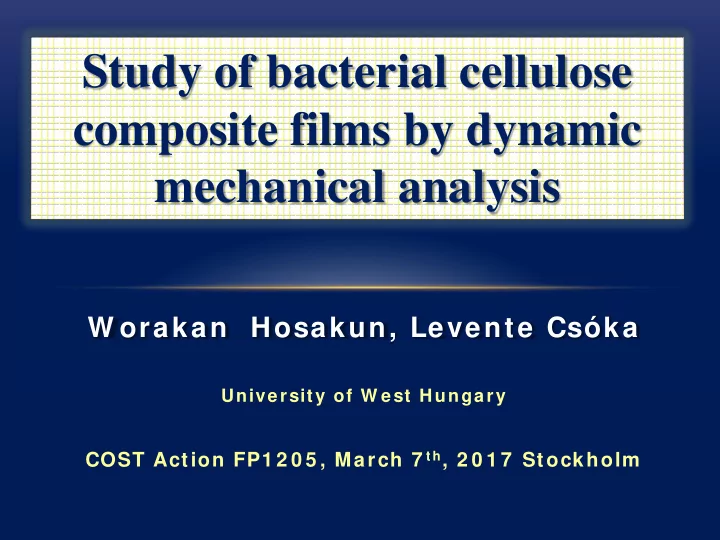

Study of bacterial cellulose composite films by dynamic mechanical analysis W orakan Hosakun, Levente Csóka University of W est Hungary COST Action FP1 2 0 5 , March 7 th , 2 0 1 7 Stockholm
O UT L I NE Objective Introduction Methodology Results and discussion Conclusions References 2
O B J E C T I V E • To prepare flexible and transparent substrates for electronic display . • The films made from: pure BC , BC/SF , and BC/SF/PVP • The shear modulus and dynamic mechanical characteristics were investigated by using DMA analysis technique 3
I N T R O D U C T I O N • Since BC and BC-based biomaterials has less environmental impacts and they can use in various fields such as biomedical area, textile, films and scaffolds, wound dressings, electronic displays, and membranes, therefore much attention has been focused on these composites. Ullah, H., et al. (2016). "Applications of bacterial cellulose in food, cosmetics and drug delivery." Cellulose 23(4): 2291-2314. 4 Yano, H., et al. (2005). "Optically Transparent Composites Reinforced with Networks of Bacterial Nanofibers." Advanced Materials 17(2): 153-155
I N T R O D U C T I O N • One of the most popular natural protein polymers for biomaterial applications is silk fibroin , derived from Bombyx mori cocoons, owing to its outstanding biocompatibility and excellent mechanical properties . Structure of silk fibroin Koh, L.-D., et al. (2015). "Structures, mechanical properties and applications of silk fibroin materials." Progress in Polymer Science 46: 86-110. Rockwood, D. N., et al. (2011). "Materials fabrication from Bombyx mori silk fibroin." Nat. Protocols 6(10): 1612-1631. 5 Irimia-Vladu, M., et al. (2012). "Green and biodegradable electronics." Materials Today 15(7–8): 340-346.
I N T R O D U C T I O N • PVP plays a significant role in the preparation of several composites and is perfectly compatible with cellulose . These composites have been widely used in various applications e.g. electronic devices , transducers, and gas sensors , owing to their unique characteristics and adaptability. BC BC/SF BC/SF/PVP Structure of PVP Khalil, A. M., et al. (2017). "Novel nanofibrillated cellulose/polyvinylpyrrolidone/silver nanoparticles films with electrical conductivity properties." Carbohydrate Polymers 157: 503-511. 6 http://www.chemicalbook.com/chemicalproductproperty_en_cb4209342.htm
M A T E R I A L S & M E T H O D 1. BC Microcrystalline BC suspension Nanocrystalline BC suspension 2. SF Nanocrystalline SF suspension 3. PVP solution 4. Film casting 7
M A T E R I A L S & M E T H O D PREPARATION OF BC COMPOSITE FILMS Table1. The compositions of the different solutions prepared. Code Microfibrillated Nanocrystalline Nanocrystal PVP (%) BC (%) BC (%) SF (%) BC control 67 33 - - S1 29 14 57 - S2 10 5 21 64 S3 6 3 13 78 8
M A T E R I A L S & M E T H O D DMA TESTING Frequency sweep • 0.2 to 20 Hz at room T. Temperature sweep • -100°C to 200°C (3°C/min) at 1 Hz. 9
R E S U L T S & D I S C U S S I O N SHEAR MODULUS Fig1. Stress-Strain curves of BC control, S1, S2, and S3. 10
R E S U L T S & D I S C U S S I O N (a) (c) (d) (b) Fig2. The effect of frequencies on storage modulus (G’) (a) and dynamic loss tangent (tanδ) (b) of BC control, S1, S2, and S3. Temperature dependence of G’ (c) and tan δ (d) of the BC control and S1, S2, and S3. 11
C O N C L U S I O N S DMA was successfully to investigate the effect of SF and PVP on the • mechanical properties of BC blended films . The shear modulus of the composite films obviously decreased • compared to BC pure film . BC film showed the greatest stiffness than other samples because it • consists of a fine web-like network . BC/SF and BC/SF/PVP films exhibited more elasticity over pure BC film. • The impact of high amount of PVP also caused the decreasing of elastic • property on the composite film because the PVP structure contained pyrrolidone groups . Therefore, increasing of PVP quantity caused the film brittle . 12
R E F E R E N C E S Irimia-Vladu, M., et al. (2012). "Green and biodegradable electronics." • Materials Today 15 (7–8): 340-346. Ullah, H., et al. (2016). "Applications of bacterial cellulose in food, cosmetics • and drug delivery." Cellulose 23 (4): 2291-2314. Yano, H., et al. (2005). "Optically Transparent Composites Reinforced with • Networks of Bacterial Nanofibers." Advanced Materials 17 (2): 153-155. Shang, S., et al. (2013). "Intermolecular interactions between natural • polysaccharides and silk fibroin protein." Carbohydrate Polymers 93 (2): 561- 573. Rockwood, D. N., et al. (2011). "Materials fabrication from Bombyx mori silk • fibroin." Nat. Protocols 6 (10): 1612-1631. Khalil, A. M., et al. (2017). "Novel nanofibrillated • cellulose/polyvinylpyrrolidone/silver nanoparticles films with electrical conductivity properties." Carbohydrate Polymers 157 : 503-511. http://www.chemicalbook.com/chemicalproductproperty_en_cb4209342.htm • Koh, L.-D., et al. (2015). "Structures, mechanical properties and applications of • silk fibroin materials." Progress in Polymer Science 46 : 86-110. 13 •
Thank you for your kind attention.
Recommend
More recommend